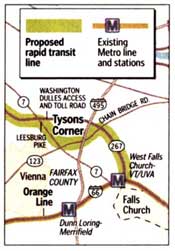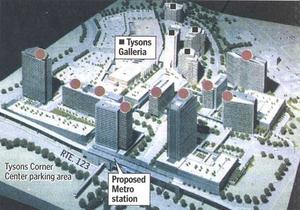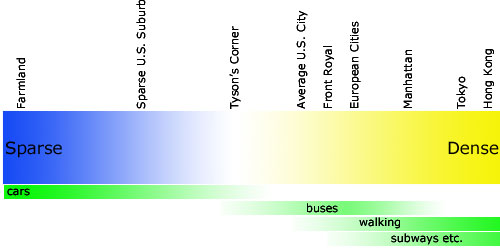
|
|
|
Tuesday 24 June 2003
Urban Planning
Suburb Hell Fairfax County, Virginia, sits just west of Washington, D.C., and is almost entirely filled with suburban development. It’s quite a prosperous place, one of the United States’ richest counties. It’s also a traffic nightmare. Most of Fairfax County’s traffic problems are the result of classic suburban-type development. Very few of the county’s buildings are more than two stories tall, and, however high off the ground you find the roof, you’ll find it a good distance from any other roof. While this obviously varies from place to place, houses, office buildings, shops, hotels, and other structures are generally set well back from the road and are surrounded by quite a bit of space. The houses have nice broad lawns, and the offices etc. have large and generally nicely-landscaped parking lots. To look at it, Fairfax County is a very nice place. Tyson’s Corner is the prime locus of business in Fairfax County, the closest thing the county has to a ‘downtown’. Since Virginia’s tax laws discourage municipal incorporation, it’s just what the post office calls a ‘named place’; it’s an unincorporated part of the county with no fixed boundaries, but most people would describe it as being bounded by the Beltway (I-495), Virginia Route 7, and Virginia 267, a.k.a. the Dulles Toll Road. Tyson’s Corner is home to two large malls, a large number of office buildings, about a dozen hotels, some condominium and townhouse developments, and at least a hundred restaurants. There’s a Metro station at the southeast corner of that area, but it’s ten miles by road — about two miles in a straight line — from the station to the intersection of Rt. 7 and Rt. 123, which is where the malls and most of the office buildings are. This is all set to change within the next ten years, though, as a new Metro line is built from the existing Tyson’s Corner-esque station (West Falls Church) to Dulles Airport. Rumor has it that when the airport was built in the early 1960s, an underground train station was built along with it. Thanks to the forward-looking attitude that you find everywhere in local Washington politics, it’ll only have had to wait for fifty years for a train to roll in.
The Metro orange line, on which the West Falls Church station lies, runs down the middle of I-66. Besides making use of the usually-wasted space in the median, this has the beneficial effect of pretty much requiring you to use a car to get to the train. The plan is to run the new line out to Dulles in the median of the Toll Road, with much the same effect. Since this route will take the new line within about a half-mile of Tyson’s Corner — which is, remember, the biggest single thing in Fairfax County — it’s generally expected that the line will make a detour, as depicted, through right through the think of things. This will violate Metro’s usual practice of routing suburban lines in such a way as to minimize their usefulness and to maximize the need for enormous parking garages, but variety is, after all, the spice of life. But now, according to this story in the Post, it appears that this might not happen at all, because the plan that Fairfax County has approved for development around the proposed Tyson’s Corner metro station is, well, just more Tyson’s Corner. That there’s to be a train line running through the middle of it doesn’t seem to have made much of an impression: the buildings are far apart and equipped with large parking lots; the streets are six lanes wide. This model shows what they propose to build: Clicking on this picture will pop up a bigger version, which will also make it easier to look at the photo while scrolling down and reading the comment on it. If you’re familiar with the area, this view is the one you’d have if you were hovering in space above the Tyson’s Corner Center — that’s the mall with the Nordstrom and the Bloomingdale’s — and looking generally north, toward the mall with the Macy’s and the Neiman-Marcus. The Beltway is just off the side to the right. The buildings marked with black squares already exist; the ones with red dots are the proposed development under discussion. This scheme — that we should spend one and a half billion dollars on a Metro line only to build precisely the same kind of thing that’s already made Tyson’s Corner a traffic nightmare most of the time — is almost unbelievably idiotic. The government transit-subsidy people haven’t missed this, and there have been hints that funding for diverting the Metro through Tyson’s Corner might not be forthcoming if this is the best they can come up with. Tyson’s Corner was a good idea for its time, one of the first edge cities. (In fact, it was the initial inspiration for the book Edge City.) No, wait, it wasn’t a good idea. It was fine when the first office buildings were built, but as soon as enough things had been built that it wasn’t the middle of nowhere, the traffic got so bad that they had to build frontage roads to allow people to get from one strip mall or office park to the next strip mall or office park down the road. The main roads were far too congested, even though they were all six lanes wide. The frontage roads allowed people to actually get somewhere, though, even though they had only one lane going in each direction. This, plus the fact that rush-hour traffic in Manhattan usually moves faster than rush-hour traffic in Tyson’s Corner, would seem to indicate that there’s something about traffic and, more generally, how human habitats work, that the people behind Tyson’s Corner don’t understand. This hasn’t caused anyone to sit down and think about what the future should bring to Tyson’s Corner, though, no sirree! We’ll have more of the same, please. Notice the spacing and proportions of the existing buildings in the aerial view above, and the spacing and proportions of the proposed buildings. They’re precisely the same, and the new buildings are, like the old, exclusively office space. There’s a 2:1 ‘density ratio’, which means that for every square foot of land area, you’re allowed to build two square feet of enclosed space, and the buildings are required to have 2.6 parking spaces for every 1,000 square feet of floor space — pretty much the same requirements as developments that don’t sit near a billion dollars’ worth of mass-transit infrastructure. This will just result in the Tyson’s Corner of the future being like the Tyson’s Corner of the present, but on an even larger scale. The traffic will still be terrible, because people won’t feel like walking a mile down a six-lane street from the Metro station to their offices. Continue down this path long enough, and the developments will start to fail as it becomes less and less attractive to locate in Tyson’s Corner. And this is the problem of the suburbs, particularly those like Tyson’s Corner: they are totally unwilling to re-evaluate themselves, and make changes, as we learn from experience. Consider this spectrum of human habitat density, from sparse to dense: The green bars show different means of moving people around; the shade of green indicates how well that means of transport works at a given density. This chart is greatly simplified — it doesn’t really differentiate between the challenge of getting around within a place and the challenge of getting to a place, for one — but it’ll do for now. At low densities, cars work well, and nothing else works at all. Since since there’s more than enough room on the road for cars, this isn’t a problem. Sparse suburbs — like those on the outskirts of big cities — accomodate cars well, too. At the other end of the spectrum, in big cities, cars don’t work well, but things are close enough together that you can walk between them without too much trouble. And things are dense enough that it’s practical to build high-cost infrastructure, like subway systems, to move people over greater distances. In the middle, though, in places that are neither sparse nor dense — in short, in places like Tyson’s Corner — there’s just no good means of transportation. It’s too far to walk between most things, and yet there’s not enough room to allow you to drive around without losing your mind. (This gap is part of the problem that Dean Kamen’s Segway was meant to solve, but in practice the things seem to be used primarily to extend one’s range within already-walkable dense areas.) When places like Tyson’s Corner were originally built, this wasn’t well understood, if it was understood at all. One of the suburbs’ advantages was that you didn’t spend all your time caught in traffic. Today, though, the denser cities are luring people back with the promise of less traffic. In most places, though, the people in charge of urban planning — such as it is — seem to inhabit some strange fantasy land, where their arbitrary ideas work. How do these people get to work in the mornings? They fly in with jet-packs, apparently; if they drove, they couldn’t help but notice the problem. My chart above may not be strictly correct; it’s based on unscientific observation, and there may be something that I haven’t noticed that could invalidate my conclusions. But what is undeniably correct is that environments like Tyson’s Corner do not function. These non-functional environments were built with the best of intentions, but circumstances have changed and resulted in problems. It’s important to proceed with the best of today’s intentions to solve the problems (or at least to cause no further harm), rather than to plow on for the next few decades with 1960s logic. Posted by tino at 18:52 24.06.03This entry's TrackBack URL::
http://tinotopia.com/cgi-bin/mt3/tinotopia-tb.pl/150 Links to weblogs that reference 'Suburb Hell' from Tinotopia. Comments
I have to disagree with your “Tyson?s Corner do(es) not function” statement. If that was indeed the case you would see real changes being made in how Tyson’s develops. I mean people would demand it. Currently however only a small minority speak out against the status quo. I do agree that ultimately Tysons Corner type development is untenable. But only when traffic becomes 18+ hours a day like current rush hour (and I know it is bad but it hasn’t reached that point yet) then you might see changes. At the very least, as you approach that point, you will see fewer people shopping there since that is an entirely voluntary trip and nearly all the stores available in Tysons have alternatives or other branches in the DC metro area. I think a BIG problem with suburban traffic is that it has come to be an accepted fact of life. People just assume there will be traffic and plan around it. Posted by: Paul Johnson at June 25, 2003 01:35 PM Well, in a way you’re right, of course. Fellow St. Louisan Yogi Berra is quoted as having said about someplace, “Nobody goes there anymore; it’s too crowded.” If Tyson’s Corner truly ‘didn’t function’, traffic there wouldn’t be a problem. Today, in the interest of science, I drove down Route 7 from Tyson’s Corner Mall to the toll road, a distance of 1.5 miles. It took me 15 minutes, which means an average speed of 6 mph. Faster than I would have thought, actually. But traffic isn’t a cause of catastrophic failure of a district the way that, say, the shutdown of a steel mill is. Assuming everything else works well enough, when the traffic gets too bad, companies and people move out. This results in a drop in traffic, so people move back in, and the whole thing repeats. This isn’t exactly a situation that’s calling out for more growth along the same lines, though. If we assume that a place like Tyson’s Corner has some kind of decade-long equilibrial cycle, adding more buildings to it makes the full-occupancy traffic worse, and the low-ebb losses on empty space greater. Presumably there’s some point at which the nastiness of the traffic and the losses on the vacancies wind up turning the place into a slum. Posted by: Tino at June 26, 2003 01:55 AM But traffic isn’t a cause of catastrophic failure of a district the way that, say, the shutdown of a steel mill is. Assuming everything else works well enough, when the traffic gets too bad, companies and people move out. This results in a drop in traffic, so people move back in, and the whole thing repeats. Very true. What we see though is over time instead of densifying (word?) exisiting suburbs the first impulse is to build farther out. And that makes a certain amount of sense. It is either closer to where the workers live or a reverse commute. Which of course pretty much seems to be the model our suburban development has been following. At this point the Washington DC area (the District, Marylan and VA) should be working to densify everything inside the Capitol Beltway instead of allowing development to more futher towards the country. However that requires 2 states and the Federal government to agree on a regional plan which seems highly unlikely….until something really breaks. Posted by: Paul Johnson at June 26, 2003 02:30 PM |
 Anyway. The plan is to build a Metro line from the West Falls Church station out to Dulles Airport, a distance of about ten miles or so.
Anyway. The plan is to build a Metro line from the West Falls Church station out to Dulles Airport, a distance of about ten miles or so.
